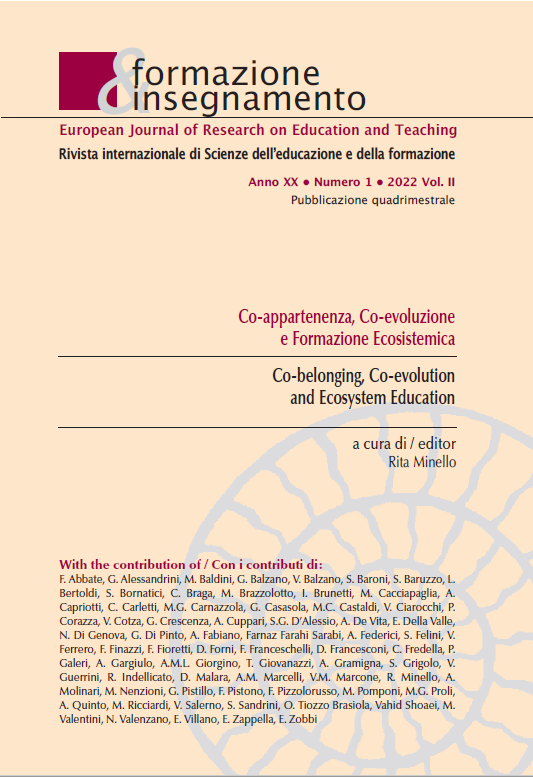Eco Gender Gap in Animated Films: Real and Fictional Gender-based Differences in Environmental Sensitivity
DOI:
https://doi.org/10.7346/-fei-XX-01-22_52Keywords:
Children's narratives, Cinema, Animation, Eco Gender Gap, EcologyAbstract
Animated films are nowadays an important and popular narrative medium that can create a socially shared imaginary. For this reason, they are considered an important indirect educational tool. One of the many applications of animation at pedagogical level is in environmental awareness, an area recently intertwined with Gender Studies. Research agrees on the existence of a marked gender gap in ecological interest (eco gender gap): data indicate that women usually approach environmental issues more effectively than men. Comparing social facts to imaginative figures proposed by narratives, similar trends emerge: if in real life ecological commitment is mainly female, also in film narratives it is mainly female characters who show a greater interest and sensitivity towards the environment. The study therefore intends to analyze some classic animated films, from Disney products to Studio Ghibli’s movies, in order to understand how the ecological issue is intertwined with gender, identifying the most relevant characters and their approach towards contact and respect for nature. The research wants to explore a parallelism between social and imaginary perception of nature and the environment, so as to open a reflection on how gender might be a determining element in the approach to ecology on different levels.
References
Anshelm, J., & Hultman, M. (2014). A green fatw ? Climate change as a threat to the masculinity of industrial modernity. NORMA: International Journal for Masculinity Studies, 9(2), 84-96.
Barsotti, S., Cantatore, L. (Eds.) (2019). Letteratura per l’infanzia. Forme, temi e simboli del contemporaneo. Roma: Carocci.
Beseghi, E (2011). Castelli erranti, città incantate, valli del vento. LiBeR, n. 39.
Brough, A. R., Wilkie, J. E., Ma, J., Isaac, M. S., & Gal, D. (2016). Is eco-friendly unmanly? The green-feminine stereotype and its effect on sustainable consumption. Journal of Consumer Research, 43(4), 567-582.
Buckingham, S. 2020. Gender and Environment. New York: Routledge.
Burgio, G. (2015). Genere ed educazione. Education Sciences & Society, 6.2.
Ciccone, S. (2019). Maschi in crisi? Oltre la frustrazione e il rancore. Torino: Rosenberg & Sellier.
Daggett, C. (2018). Petro-masculinity: fossil fuels and authoritarian desire. Millennium, 47(1), 25-44.
Dello Preite, F. (Ed.) (2019). Femminicidio, violenza di genere e globalizzazione. Lecce: PensaMultimedia.
Faeti, A. (1983). La «camera» dei bambini: cinema, mass media, fumetti, educazione. Bari: Edizioni Dedalo.
Forni, D. (2019). Genere e cartoni animati. La formazione dell’immaginario femminile attraverso i cartoon. In S. Ulivieri (Ed.). Le donne si raccontano. Autobiografia, genere e formazione del sé (pp. 405-416). Pisa: ETS.
Forni, D. (2020). Amare e proteggere il mare. La letteratura per l’infanzia e la sensibilizzazione ambientale. In G., Annacontini & C., Birbes (Eds.). Scenari di futuro: creatività e immaginazione per lo sviluppo sostenibile. Bergamo: Zeroseiup.
Glotfelty, C., & Fromm, H. (Eds.) (1996). The Ecocriticism Reader: Landmarks in Literary Ecology. Athens: University of Georgia Press.
Hunt, E. (April 2020). The Eco Gender Gap: Why Is Saving the Planet Seen as Women’s Work?. The Guardian.
Le donne sono molto più ecologiste degli uomini. (2019, 20 Novembre). Repubblica, online.
McCright, A. M., & Dunlap, R. E. (2011). Cool dudes: The denial of climate change among conservative white males in the United States. Global environmental change, 21(4), 1163-1172.
Merchant, C. (2017). Ecofeminism and Feminist Theory. Science and Nature, 250–260.
Morin, E. (2005). The Cinema, or the Imaginary Man. Minneapolis: University of Minnesota Press.
Murray, R., Heumann, J. (2011). That’s all Folks: Ecocritical Readings of American Animated Features, Lincoln: University of Nebraska Press.
Okuhara, R. (2006). Walking Along with Nature: A Psychological Interpretation of My Neighbor Totoro. The Looking Glass: New Perspectives on Children’s Literature, 10(2).
Paulé, P., & Hultmann, M. (2019). Industrial/Breadwinner Masculinities and Climate Change: Understanding the ‘White Male Effect’ of Climate Change Denial. Climate Hazards, Disasters, and Gender Ramifications. Oxon/New York: Routledge.
Thevenin B. (2013). Princess Mononoke and beyond: New nature narratives for children. Interactions: Studies in Communication & Culture, 4(2).
Trisciuzzi M. T. (2013). Hayao Miyazaki. Sguardi oltre la nebbia. Milano: Mimesis.
Ulivieri S. (1999). Modelli e messaggi educativi al femminile nella fiaba. In F. Cambi (Ed.), Itinerari nella fiaba. Pisa: ETS.
Whitley, D. S. (2008). The idea of nature in Disney animation. Ltd.: Ashgate Publishing.
Downloads
Published
How to Cite
Issue
Section
License
Copyright (c) 2022 Dalila Forni

This work is licensed under a Creative Commons Attribution 4.0 International License.
Formazione & insegnamento is distributed under Attribution 4.0 International (CC BY 4.0).
For further details, please refer to our Repository & Archiving Policy, as well as our Copyright & Licensing Terms.





